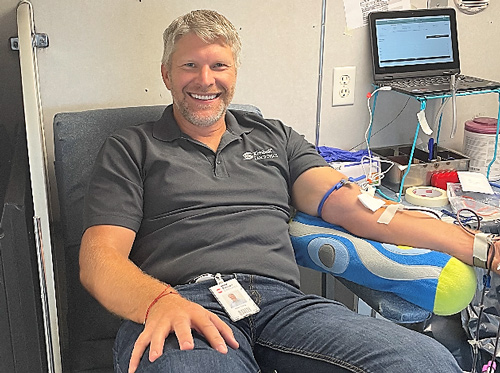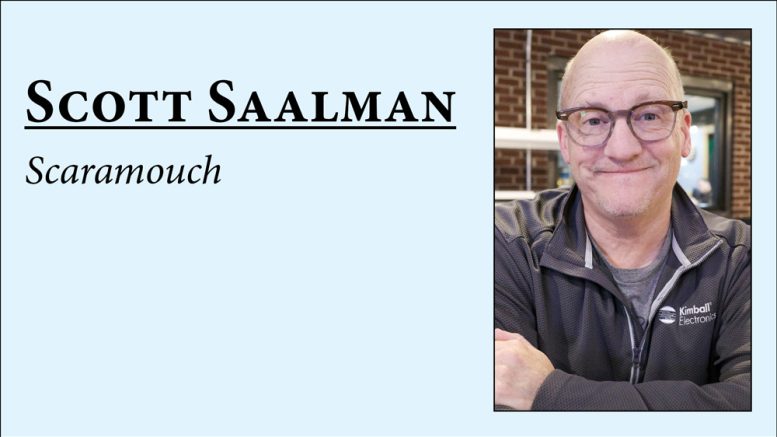The first time I donated blood, I passed out.
I was 18, barely weighing the 110 pounds necessary to donate.
I survived the actual blood draw. It was afterwards that it did me in.
The Red Cross lady removed the needle and tube from my inner elbow, bandaged and wrapped it. She helped me sit at the table’s edge. A man offered his body as a human walker for transport to the snack table. I shrugged him off. I took a few steps, saw spots, and felt oddly light. The gym floor gave way like a trampoline.
Being passed out brought a wonderful sense of peace. It was better than a calculus class coma. Coming to, I found myself supine on the gym floor. The beastly wrestling coach, kneeling, held my knees in an upward bend. I had no idea why he was demonstrating one of his demonic wrestling holds on me. I wasn’t even on the wrestling team.
His demeanor always scared me. He hailed from the mean streets of NYC and brandished that fact like the badge of a perpetual badass. It worked on us southern Indiana boys. It kept us in line in the hallways.
While he held my knees, his usually gruff voice sounded unusually soft. “You’ll be alright, Saalman,” he said. He hollered over his shoulder, as if a real life and death drama had unfolded, “Get Saalman a cookie.” Then, calm and concerned, he said, “Do you like chocolate chip, Saalman? What’s your favorite cookie?”
Talk about surreal. I never dreamed I would be talking cookies with the wrestling coach. I was still confused as to why we were wrestling.
“You just gave blood, Saalman,” he explained.
“Oreo,” I responded.
When I sat upright, the gym exploded with clapping students, as if I were a football player, who, after a few motionless minutes, miraculously rose from the turf following a nasty, whip-lashing hit. In my case, though, any compassion soon dissolved into comedy.
“Get Saalman a cookie,” a wiseacre shouted from the top bleachers, mimicking the wrestling coach. His followers chanted the same. These hecklers were my closest pals. With friends like that, who needs enemas?
I didn’t donate blood again until my mid-30s. I did not faint the second time, nor ever again. A full stomach beforehand helps ensure this.
I became very consistent in donating blood, up until COVID-19 struck. Only in the latter part of last year, after learning of a national blood shortage (a crisis due perhaps to back-pedaling, pandemic-driven pausers like me), did I recommit to this heroic practice when I returned to the bloodmobile and donated a pint during an event hosted by my employer, Kimball Electronics, in Indianapolis.
I know many people who donate blood, but I know far more people who don’t. The latter is puzzling. Consider some facts from the American Red Cross:
- The need for blood is constant. Every two seconds someone in the U.S. needs blood.
- More than one million new people are diagnosed with cancer each year. Many of them will need blood, sometimes daily, during their chemotherapy treatment.
- A single car accident victim can require as many as 100 pints of blood.
- One in seven patients entering a hospital will need a blood transfusion.
- Every day, Red Cross blood donors are the lifeline for car accident victims, parents with complicated childbirths, individuals battling cancer and people with sickle cell disease.
So, why not donate?
Some people have a morbid fear of needles.
Some people get freaked out imagining an entire pint of blood exiting their body. After all, a body houses only about 10 pints. But guess what? The body recreates the missing blood.
Many people just don’t even think about donating.
There’s a 1963 John Updike short story, called “Giving Blood,” that addresses the worry of Richard Maple as he travels with his wife to Boston to donate blood, a first for him. “Sweetie,” Richard blurted, “will they hurt me?” Adds Updike, “…he had, less through his own determination than through the diffidence of the solicitors, evaded pledging blood. It was one of those tests of courage so trivial that no one had ever thought to make him face up to it.”
So, does it hurt?
For me, the worst part is the quick finger prick – a slight pain – that has to happen to test your hemoglobin.
For some, it’s not the blood they don’t want to donate, it’s the time.
According to the Red Cross, “The actual blood donation typically takes less than 10-12 minutes. The entire process, from the time you arrive to the time you leave, takes about an hour and 15 min.”

Doug Hass of Carmel donates blood at a Kimball Electronics blood drive. (Photo provided by Scott Saalman)
I donate the time and blood because I want to make a difference in someone’s life, just as donors made a difference for my mother in 1963. The baby arrived 10 weeks premature, 2 pounds, 8 ounces, dying six hours later. For four days, my mother hemorrhaged. My father’s co-workers rushed to the hospital to donate blood. Mom lived, giving birth to me the following year. I’m happy to be here. I have coworkers whose family members lives were saved due to blood donations, too.
When I fret over the time it takes and the fear of the pinprick, I simply ask myself, “How can I not donate blood?”
Consider the Red Cross statistics and ask yourself, “How can I not donate blood?”
Updike was right. If no one makes you face up to doing it, why do it?
It’s a little test of courage that makes big impact.
I’m asking you to face up to it.
Remember, there are free cookies and other snacks in it for you, something I deprive myself of at home. That’s another reason I do it.
Contact: scottsaalman@gmail.com

